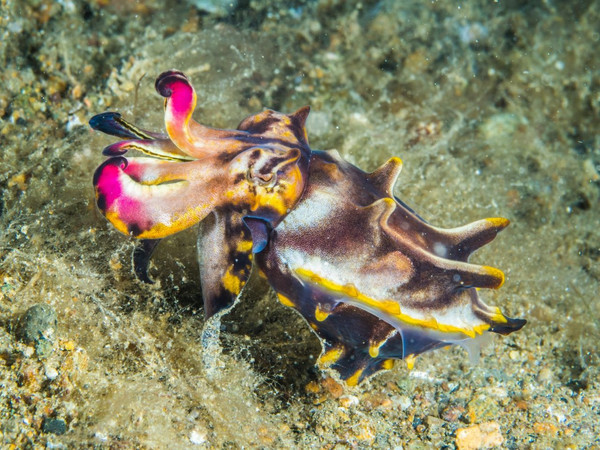Manta Ray
See Our Perfect Planet: Oceans
Here’s a perfect fact from the fourth part of A Perfect Planet, the new BBC series of wildlife wonders narrated by Sir David Attenborough: did you know that every drop of seawater is driven around the world by the earth’s currents, taking 1,000 years to do the circuit? The question is: how did they find that out?
Fortunately, it doesn’t take quite so long for a TV blockbuster to get around the globe, so we were treated to some great stories from every watery corner of the oceans, from the Humboldt Current at the Galápagos Islands to the Indonesian Throughflow to the tidal surge at Saltstraumen in Norway. As usual, there were some great stories and sequences, from the colourful courtship of the Flamboyant Cuttlefish to the multiple perils in the shallows for Hardyhead fish in Australia.
Cruises are very much a part of the Naturetrek programme, which means that you yourself can follow in the footsteps (flipper-sweeps) of this episode, not least by making for the richest marine environment in the world. If you thought that was the Barrier Reef, it isn’t; it’s the Coral Triangle around the islands of Indonesia, with its 3,500 species of fish. This figure includes both the Surgeon Fish and the incomparable Manta Ray, which were featured on screen. Admittedly you won’t see the rays feasting on the clouds of the Surgeon Fish eggs, but imagine what you might see while snorkelling this almost unbelievably stunning corner of the oceans? Reef-life is a wonder everybody should experience if they possibly can.

The Galápagos Islands have featured heavily in the series so far, and in this episode we found that Marine Iguanas have just as much drudgery in their lives as do their land equivalents, whom we met earlier in the series clambering up and down a vast crater to lay eggs in geothermally heated soil. If you’re a Marine Iguana, you spend about 30 minutes a day swimming to the rafts of seaweed growing offshore, grazing on it and then returning. This is pretty much all you do all day; any longer in the cold waters of the Humboldt Current and you won’t get back alive. There’s nothing to eat on the island of Fernandina, unless you steal the nest material of the Flightless Cormorants. The island is one of many that we visit on our Galápagos cruises.
Of course, you don’t have to go on a cruise to enjoy marine wildlife; coastal tours, with your feet planted firmly on dry land, can be just as good. If you enjoyed the sight of the Eiders packing into the narrow waters of Saltstraumen, why not go on something of an Eider special? On our 5-day trip to the Varanger Fjord in Arctic Norway you don’t just see lots of Common Eiders, but King Eiders and Steller’s Eiders too. All these powerful marine ducks feed on submerged shellfish, but if anything, the King Eider prefers even deeper and stormier waters than the Common Eider, and the Steller’s is a serious contender for the world’s most beautiful duck. Checking through thousands of birds for these rarities is a genuinely thrilling, especially in the bracing cold of the Arctic.

Bali to Komodo - In Search of the Dragon!
Thursday 20th October - Monday 31st October 2022 - £6,795
Saturday 9th September - Thursday 21st September 2023 - £6,795
Tailormade Cruises
Galápagos Islands - one week cruise
Monday 1st November - Saturday 13th November 2021 - £6,495
Monday 2nd May - Saturday 14th May 2022 - £6,495
Norway's Varanger Fjord
Wednesday 16th March - Sunday 20th March 2022 - £2,495



 Loading search...
Loading search...




